Samsung Galaxy S 2 (International) Review - The Best, Redefined
by Brian Klug & Anand Lal Shimpi on September 11, 2011 11:06 AM EST- Posted in
- Smartphones
- Samsung
- Galaxy S II
- Exynos
- Mobile
Battery
Even though it’s almost at the end of our review, battery life is hugely important, and measuring up how SGS2 does compared to the competition is a large part of what makes things pretty positive for the device. As a reminder, we measure battery life by having the browser load through a few dozen pages with brightness set on 200 nits until the phone dies, on both WiFi and cellular (WCDMA). The SGS2 has a capacious 6.11 Whr battery, which is among a small number of devices I’ve seen that come with over a 6 Whr battery by default.

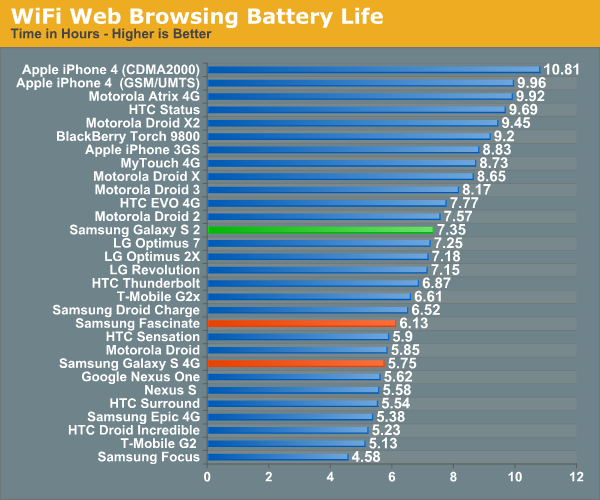
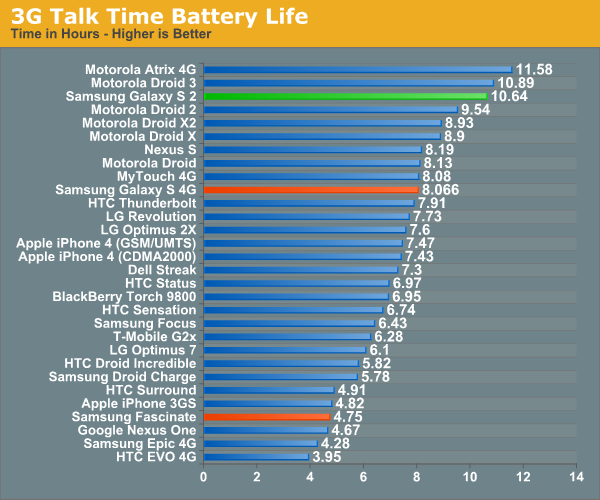
The SGS2 outperforms its predecessors pretty handily, and I’ve highlighted in orange those results from the Galaxy S 4G and Fascinate. When you factor in that SGS 4G has the same capacity 6.11 Whr battery, it’s obvious how much of the gains are both SAMOLED+ efficiency and a dual core SoC.
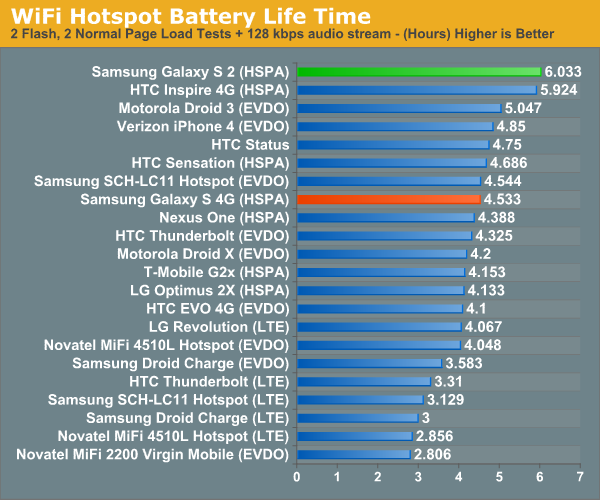
In the WiFi hotspot test, the SGS2 actually trounces everything else I’ve seen thus far as well, edging out the Inspire 4G. As a reminder, that test consists of loading 4 sets of the page load test alongside a 128 kbps MP3 stream with the display off until the phone dies.
The last thing to talk about with respect to battery life is the infamous “AOS Bug,” where AOS references the Android OS line item in the battery use window. I’ve read just about everything there is I could find on this bug, and believe it to just be related to how Android reports this metric based on CPU time that a process and its children use. Some have speculated this is something which has showed up with dual core SoCs. To be completely honest, I don’t put much stock in the line-item breakdown of battery use to begin with, what I look at is the graph view. Either way, the battery numbers above speak for themselves, and SGS2 battery life is definitely superior to the predecessor, AOS issue or not.
Conclusions and Final Thoughts
It’s always difficult to sum up a device like the SGS2, because this is such a major launch and so much has already been written and discovered about the phone. I find myself again thinking back to how long it’s been since we first played with the SGS2 at MWC and just how far the device has come. It literally is a completely different device today than what Anand and I played with chained to a table in Barcelona.
There’s no doubt in my mind that SGS2 is the most powerful smartphone out right now, both in the synthetics and in just subjective feel. That’s thanks in large part to Exynos 4210’s dual core Cortex A9s at 1.2 GHz and ARM’s Mali–400 GPU. The end result is an experience that’s buttery smooth and rarely shows any signs of being want for more power. Mali–400 alone is twice as fast as any other smartphone GPU out right now, and Exynos 4210 seems likely to vie for performance crown in Android-land until the start of 2012.
The original Galaxy S was a hugely popular Android phone, and thankfully the few issues that were around that generation have been ironed out this second time around. The result is a device that is better in almost every category. Battery life is longer than the predecessor. Performance is much higher. Super AMOLED uses the much more readable RGB stripe. GPS works this go around. Camera stills and video are awesome. The list goes on.
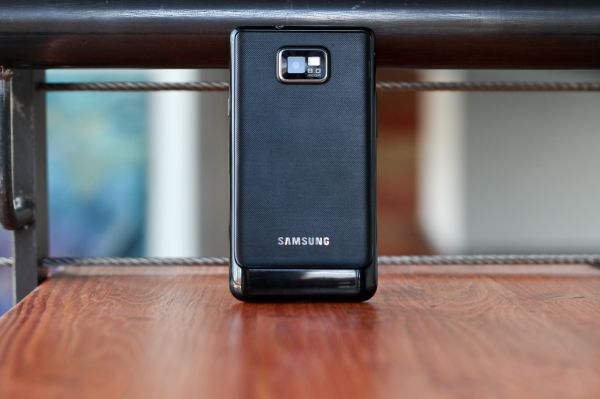
Some Photos Courtesy Sarah Trainor
That said there are still a few lingering areas which the SGS2 wavers. Audio quality from the Yamaha codec in the SGS2 isn’t up to the level of quality the Wolfson was capable of, and there are some potentially frustrating baseband instability issues we ran into as well. There’s also the notable omission of NFC in all but the Korean version of the SGS2, and it looks as though only certain variants coming to the USA will have NFC.
The international market is a whole lot more efficient than the situation we have to deal with here in the USA. Phones launch in largely the form the manufacturer originally intended them to, and as a result there’s a single target for both enthusiast ROM modders and the handset vendor to build and test software on. More and more, it’s really that kind of long-term support that makes a handset valuable, and SGS2 is such a huge success already that it isn’t likely to be obsolete in just a few months, even with Kal-El phones and a new Nexus looming on the horizon.
I really have to admit that I went into this review expecting to be massively underwhelmed with Galaxy S 2. Here we are at the end though, I find my thoughts about the device completely changed. Even taking into account the near term Android roadmap, Galaxy S 2 is the Android smartphone I’d absolutely buy today.



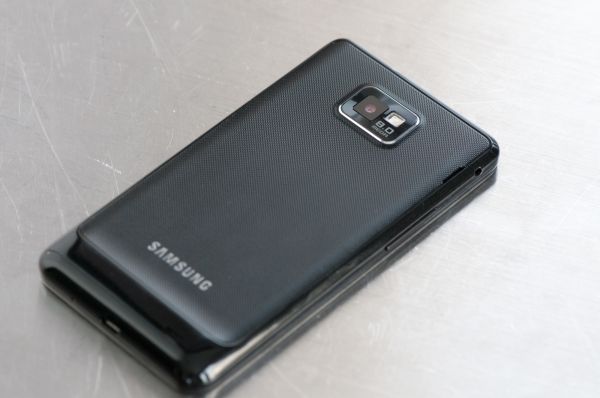








132 Comments
View All Comments
Mugur - Tuesday, September 13, 2011 - link
Well, for most Android devices I've tried (I currently own 3), if you just leave them doing nothing overnight (even with wifi on on some of them, but no 3G/HSDPA, no GPS etc.) the battery drain is like 2-3%. Of course, if some app or push email or an updating widget wakes them, the drain could reach 20-25%.You just have to play a bit with the phone and find out what is mostly consuming your battery, even get one of the "green" apps on the Market. Through experimentation, I'm sure most people (excluding the really heavy users) will get 50% more time of the battery.
wuyuanyi - Monday, September 12, 2011 - link
It must be the final answer for my pending problem.my GS II has this problem and I has been very annoyed.the CPU current produce a EMI on the output circuit ,for the BT earphone DOESN'T play such hiss and noisy.apprecite it to solve my problem rather than suspect whether it is my own case. but the next question is how to solve it ? can we manual fix the shield or , generate a noisy that is against the noisy --with reverse wave?hehe
sorry for my poor ENGLISH
awesomedeleted - Monday, September 12, 2011 - link
This is a fresh copy of my current phone...Samsung Infuse 4G...which came out in May. I hate the newer Galaxy S round home button thingy too. What's so special, the name?awesomedeleted - Monday, September 12, 2011 - link
Although I now notice a few small differences in hardware, such as 1.2Ghz Dual-core A9 vs. my Infuse's 1.2Ghz Single-core A8, and the 1GB RAM.supercurio - Monday, September 12, 2011 - link
Infuse 4G is a Galaxy S "repackaged" with a Galaxy S II look, screen and probably camera sensor for AT&T.bmgoodman - Monday, September 12, 2011 - link
So I understand that the audio quality of this phone is a step down from the original galaxy. My question is how big a step down? For a non-"audiophile" who just wants to connect the headphone jack into the AUX port on his OEM car stereo to listen to his variable bit rate MP3 (~128 bps IIRC) music collection, is this something that's likely to disappoint? Is it a notable shortcoming for a more typical music fan?supercurio - Monday, September 12, 2011 - link
No doubt cars are in general a noisy environment.Furthermore its very rare to find cars benefiting from good speakers and implementation, resulting in far from linear frequency response, left/right imbalance, resonance in other materials etc :P
Trained ears or sensible people are capable of detecting subtle difference in sound like nobody can imagine ^^ but I don't think it will Galaxy S II DAC issues described will make a noticeable difference when listening to music while driving a car for most people.
Note: I have no idea how was the original Samsung Galaxy phone on this regard, but its a regression over Galaxy S.
Headphones.. that's something else because even cheap ones (price doesn't matter) can provide some low distortion levels and let your perceive fine details.
Deusfaux - Monday, September 12, 2011 - link
It is there and does work, speaking from experience with a Nexus S.Deusfaux - Monday, September 12, 2011 - link
An HTC I used did it best though, with integrating the feature right into the browser settings. No special URL strings needed to access functionality.aNYthing24 - Monday, September 12, 2011 - link
But isn't there a version of the Tegra 2 that is clocked at 1.2 GHz? It's going to be at that clock speed in the Fusion Grid table.t